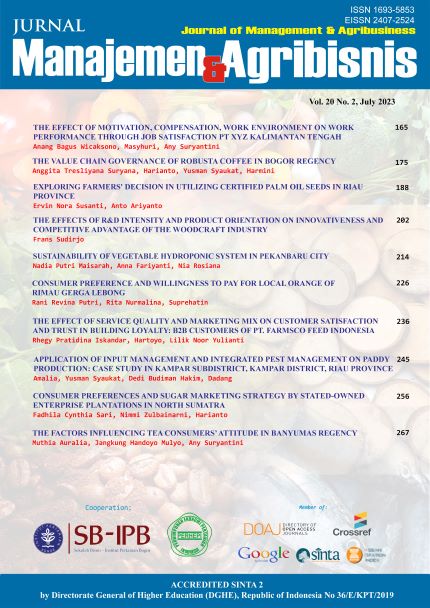Abstract
Tuna is believed to be one of the world's most popular fish with high economic value. Tuna is very sensitive to temperature changes; therefore, quality control must be carried out from the supplier to the customer stage. The quality of tuna then impacts the amount of revenue received by each supply chain. The objectives of this research are to identify the configuration of the tuna supply chain in Ternate City, analyze the risk of the tuna supply chain, and propose risk mitigation strategies for the tuna supply chain in Ternate City. The research focuses on fishermen, traders, and processors. Sampling was based on non-probability sampling, where the collection of information and knowledge from experts used a purposive sampling method to determine the experts involved in the research. The number of respondents was two fishermen, two traders, and three processing companies. Potential risks were analyzed in fuzzy (Hor-1). Furthermore, several mitigation actions were carried out, which were then analyzed using fuzzy (Hor-2). Risk agents and risk events were identified based on all activities mapped using the Supply Chain Operations Reference (SCOR) model. Most tuna is delivered to fulfill domestic needs, with 58% going to inter-island traders and large processors or exporters. The ARP value with a cumulative 80% indicates that there are seven priority risk agents in fishermen, four priority risk agents in traders, and thirteen priority risk agents in processors that need to be mitigated. Training for fishermen on good fish handling on board and fish handling training for traders and processors are priority mitigation strategies that can be carried out to maintain the quality of tuna in all members of the supply chain.
Keywords: fuzzy -HOR, risk management, SCOR, tuna supply chain
Authors
Authors who publish with this journal agree to the following terms:
- Authors retain copyright and grant the journal right of first publication with the work simultaneously licensed under a Creative Commons Attribution License that allows others to share the work with an acknowledgement of the work's authorship and initial publication in this journal.
- Authors are able to enter into separate, additional contractual arrangements for the non-exclusive distribution of the journal's published version of the work (e.g., post it to an institutional repository or publish it in a book), with an acknowledgement of its initial publication in this journal.
- Authors are permitted and encouraged to post their work online (e.g., in institutional repositories or on their website) prior to and during the submission process, as it can lead to productive exchanges, as well as earlier and greater citation of published work (See The Effect of Open Access).

